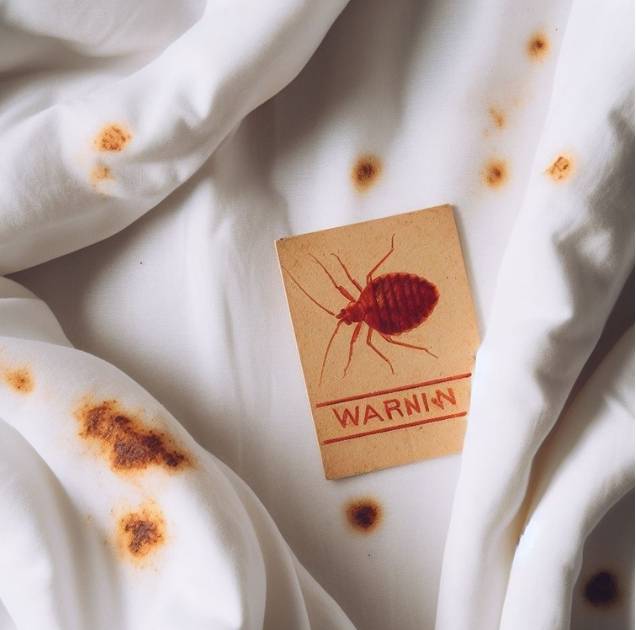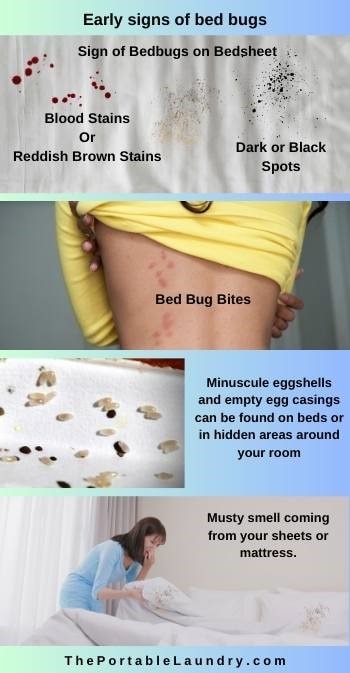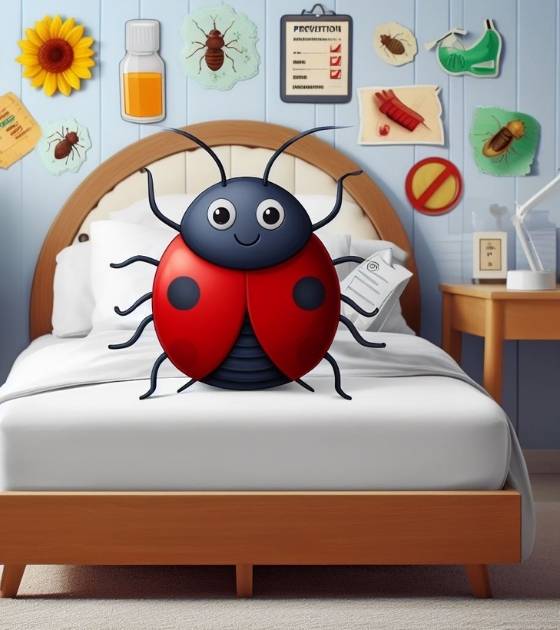If you’ve ever had a bed bug infestation, you know just how difficult it can be to get rid of the little pests.
Not only do they multiply quickly, but they also leave behind telltale stains on your sheets and mattress.
If you’re struggling to remove those early bed bug stains, this blog post is tailor-made for you.
In this blog post, you will learn how to remove those pesky stains using simple household ingredients.
Let’s dive right in.
Table of Contents
What do early bed bug stains look like on sheets, and how can you tell if you have them?

Some of the common signs to look out for include a musty smell, and small reddish-brown stains on your sheets or mattress.
These stains can be caused by bed bugs excreting their fecal matter onto the sheets or mattress.
In addition, if you notice a musty smell coming from your sheets or mattress, this could also be an indication of bed bugs.
With all that said, there are quite a few obvious indicators of the presence of bed bugs in your house.
Let’s take a quick look at some of the obvious and early signs of the presence of bed bugs.
Early signs of bed bugs

In addition to the stains that bedbugs leave behind, there are other signs that indicate the presence of these pests.
Reddish brown stains
You may see small, reddish-brown stains on your sheets or mattress.
This happens when bed bugs leave their waste on the sheets or mattresses.
Musty Smell
If you notice a musty smell coming from your sheets or mattress, this could also be an indication of bed bugs.
Eggs and Eggshells
A sure sign of a bed bug infestation is the presence of their minuscule eggshells and empty egg casings.
Bed bugs lay their eggs in small, hidden areas around your home.
You can find these eggs by looking for tiny white spots.
Dark Spots
In some cases, the dark spots you see on your sheets are actually the excrement left behind by bed bugs.
Blood Stains
Bed bugs feed on the blood of humans and animals, so one sure sign of an infestation is the presence of blood stains.
These stains can bleed onto the fabric and cause blood stains.
Bed Bug Bites
If you are experiencing unexplained itchy, red bumps on your skin, this could be a sign of bed bug bites.
When these bed bugs bite, it triggers itching, causing your skin to become inflamed.
Where do bed bugs hide?
Bed bugs commonly hide in mattresses, box springs, headboards, furniture upholstery, and baseboards.
They can also hide in cracks in walls or floors, electrical outlets, and behind wallpaper.
With all that said, bed bugs typically hide around the bed, near the piping and tags, when they’re not feeding.
How to get rid of early bed bug stains from sheets?
Let’s be honest, dealing with bed bugs can be tough, and they keep coming back no matter what you do.
Stains are just the byproduct of bed bug infestations, and they can be difficult to remove.
Fortunately, there are several ways you can get rid of this pesky stain.
But before that, a quick word of caution.
A word of caution
The longer you wait to take action against bed bugs, the more difficult it will be to get rid of them. Bedbugs are small insects that feed on blood, and if they’re not removed quickly, they can grow exponentially. In most cases, you should be able to manage a small infestation by yourself. However, the growth of bed bugs is extremely fast, so it is important to take action quickly, preferably by contacting a professional pest control service to get rid of these pests permanently.
How to clean bed bug stains?
Bed bug stains can be a real pain to remove, regardless of the fabric type.
But with a little know-how and some elbow grease, you can get those pesky stains out in no time.
How to clean bed bug stains from washable sheets?
Step 1: Pre-treat the sheet
Before you wash your fabrics, apply the stain remover to any visible stains and allow it to work for 10 minutes or so.
In most cases, the stain remover will have specific instructions on how to use it mentioned on the label, so make sure you follow the instructions carefully.
If you don’t have the stain remover handy, you can prepare a stain remover solution at home by mixing detergent and vinegar in a bowl of warm water and using that solution as a stain remover.
Step 2: Wash the sheets
Once you’ve pre-treated the stains, you can either hand-wash or machine-wash the sheets.
Hand Washing
If you opt for handwashing, make sure the water is lukewarm and add a generous amount of detergent to a tub or sink filled with water.
Next, swish the sheets around in the water to ensure they are thoroughly soaked.
Then, work on the sheet with your hands to eliminate the stains and wash the other areas.
Machine washing
If you prefer machine washing, make sure you check the label on the sheet for the recommended settings and use a gentle cycle.
For the best results, put your regular detergent in the washer’s automatic detergent dispenser or directly in the drum.
For better results, you can even pour half a cup of distilled white vinegar into the drum directly.
Next, set the washer to the recommended wash cycle mentioned on the care label.
If the care label is not clear, you can set the wash cycle to normal.
And if the fabric is compatible with a hot water wash, set the washer to run on a hot cycle.
Step 3: Dry the sheets
The next step is to dry the sheets once the wash cycle is complete.
So, after you are done washing the clothes, promptly put them in the dryer and set it to run on the highest setting possible (only if the care label recommends).
If you are not comfortable using a dryer, you can also hang the sheets in the sun to dry.
Sunlight is one of the most effective ways to eliminate bed bugs.
Step 4: Place the sheet in an air-tight plastic bag
The last step is very important because there is a high chance that the bed bug may come back unless you have treated the root cause, i.e., eliminating the bed bug permanently from your house by consulting professional pest control services.
What is the best way to clean bed bug stains from dry-clean-only fabrics?
The easiest way to get rid of bed bug stains from dry clean-only fabric is to take it to professional dry cleaners.
They have the necessary tools and experience to remove tough stains from almost any fabric.
However, if you want to do it yourself, follow the steps below.
Step 1: Pre-treating the stains
If you don’t want to take your delicate fabrics to the dry cleaners or if the bed bug stains are still fresh and visible, you can try treating them first with an enzyme-based laundry stain remover.
Most of the time, enzyme-based laundry stain removers should be able to get rid of stains on dry-clean-only fabrics without damaging them.
Step 2: Use a dry cleaning kit
The next step is to use a dry-cleaning kit to clean the entire sheet.
Just put the sheet and cleaning cloth that come with the dry-cleaning kit into the fabric protection bag. Next, put the fabric protection bag in the dryer and tumble it on medium heat for 15 to 30 minutes.
Step 3: Air out the fabric
Once you’ve finished using the dry cleaning kit on the sheet, give the sheet a pat and get rid of any residues.
Finally, hang the sheet in a well-ventilated place and let it air out for a few hours.
It’s best to hang the sheet in the sun or leave it outside for some time so that all the residual gases from the dry cleaning kit can evaporate before bringing them back inside your house.
How to clean bed bug stains from mattresses?
Step 1: Remove the cover
The first step is to remove the mattress cover or any fabric layers that are on the mattress.
If there are any removable covers, pillows, or cushions, take them off and wash them separately.
Step 2: Vacuum the mattress
The next step is to vacuum the mattress, paying special attention to any crevices and seams.
This will help to remove any bed bugs, eggs, or debris that may be on the mattress.
Step 3: Prepare a stain-removing solution
Now, prepare a solution of warm water, vinegar, and detergent or soap.
If you don’t want to make the pre-treating solution at home, you can use a stain-removing solution that will work.
Step 4: Remove the stains
Using a soft cloth, gently rub this solution over the spots where bed bug stains are visible.
Let the solution do its magic by allowing it to sit for a few minutes. Next, wipe the solution off with a clean cloth.
Step 5: Steaming
A clothes steamer is capable of killing bed bugs as the steam temperature can reach up to 180 °F.
While using a clothes steamer, just make sure to keep the steamer at least 4 to 6 inches away from the fabric.
Step 6: Drying the mattress
After you have completed the above steps, lay your mattress out in the sun or in a well-ventilated area to dry.
You can also use a fan or a dehumidifier to dry the mattress.
Once the mattress is completely dry, you can put on a clean mattress cover and use it again.
Prevention tips to avoid getting bed bugs in the first place

- Keep your home clean and clutter-free.
- Regularly vacuum the floors, carpets, and furniture.
- Check for bed bugs when traveling, as they can also travel with you.
- Be aware of second-hand furniture and inspect it extensively before bringing it home.
- Wash your sheets, pillowcases, and bedding regularly in hot water if the fabric is suitable for a hot water wash.
- Store your clothing and bedding in sealed plastic bags to prevent bed bugs from getting into them.
- Regularly inspect your mattress for bed bugs and signs of infestation. If you suspect that your home has a bed bug infestation, contact a professional pest control expert immediately.
- Use natural insect repellents like cedar oil and peppermint oil to deter bed bugs.
- Use mattress encasement or special bedbug-proof covers for mattresses and box springs.
- Lastly and most importantly, perform pest control treatments once a year.
Quick Summary/Key takeaways
- Early Detection is Key
- Detecting bed bug infestations early is crucial to minimize treatment costs and prevent the spread to other areas or properties.
- Bed Bug Identification
- Skin bites alone are not a reliable indicator of bed bug infestations as they can resemble bites from other insects or skin conditions.
- Identifying physical signs, such as stains, excrement, eggs, and live bed bugs, is a more accurate method for potential infestations.
- Physical Signs of Bed Bugs
- Rusty or reddish stains on bed sheets and mattresses indicate crushed bed bugs, a clear sign of their presence.
- Dark spots resembling small ink stains are a result of bed bug excrement, another indicator of infestation.
- Tiny eggs and eggshells, typically around 1mm in size, signify the growth of bed bug nymphs.
- The presence of live bed bugs themselves serves as a definitive sign of infestation.
- Common Hiding Spots
- Bed bugs are known to hide in various areas around the bed, including mattress seams, tags, and the bed frame.
- In heavily infested rooms, they may extend their hiding spots to chairs, couches, curtains, and electrical receptacles.
- Their ability to hide in tiny cracks and crevices, often as wide as a credit card, makes them difficult to detect.
- Understand the Bed Bug Behavior to deal better
- Bed bugs primarily feed on humans but can also feed on other animals if necessary.
- They can travel distances of 5-20 feet in search of a host and may even feed during daylight hours if they are hungry.
- Feeding typically takes 3-12 minutes, and blood meal remnants may be left behind.
- Bed bugs go through six life stages, requiring a blood meal at each stage.
- Both males and females must feed every 14 days to mate and reproduce.
- A single female can lay 1-3 eggs per day and up to 500 eggs in her lifetime.
- The egg-to-egg life cycle usually spans 4-5 weeks under favorable conditions.
- Survival and Distribution
- Bed bugs can endure temperatures as low as 7°C but are susceptible to temperatures at or above 45°C.
- To eliminate them with heat, the room must be heated even hotter.
- While common bed bugs are found worldwide, tropical bed bugs tend to favor warmer regions.
Final Thoughts
Bed bugs can be a real nuisance and embarrassing as well, especially because they tend to leave behind telltale stains not only on your sheets but also on your mattresses and other fabrics in your home.
While you can remove the stains from sheets, they’re likely to return unless you fix the underlying cause permanently.
Therefore, getting a pest control service to help you with the issue is often a better idea.
When it comes to prevention, make sure you keep your home clean and tidy, as bed bugs are drawn to clutter and mess.
Also, inspect your bedding regularly for any signs of bed bugs, and if you find any, act quickly.
Frequently Asked Questions
Are bed bug stains permanent?
No, bed bug stains are not permanent and can be removed with the right cleaning techniques and stain removers. You can either make a homemade stain remover or use a commercially available product.
What is the best way to get rid of bed bugs?
The best way to get rid of bed bugs is to contact a professional pest control service. They can help you identify the source of the infestation and use effective treatments to get rid of them. Using home remedies to get rid of bed bugs is less likely to work.
Can bed bugs stay on sheets after washing?
Washing alone may not be sufficient to eliminate all bed bugs. However, the heat generated in a dryer for drying the sheet will certainly kill the bed bugs.
You May Also Like
- How to remove coffee stains from clothes?
- How to remove Grass Stains from clothes? (Easy Way)
- How to Remove Acrylic Paint Stains from Clothes?
- How to remove shoe polish stains from clothes?
- How To Remove Turmeric Stains from Clothes?
- How to Remove Fabric Softener Stains Out of Clothes?
- How to wash socks? (Hand Wash & Machine Wash)
- How to wash Hanes white tees? (Step-by-Step)
- How to Wash Spirit of the Sea Billabong Tee (T-shirt)?
- How to clean dirty Collars and cuffs?
- Is it safe to wash clothes with gasoline on them?
- How to wash sweaters? (Hand & Machine Wash Covered)
- Do ozone laundry systems work? (Explained)
- How To Use a Scrubba Portable Clothes Washing Bag?
- Can North Face Jackets be washed in the washing machine?
- Can You Wash Quick Dry Sheets in Washing Machine?
- How do you wash LulaRoe jeans? (5 Methods Covered)

